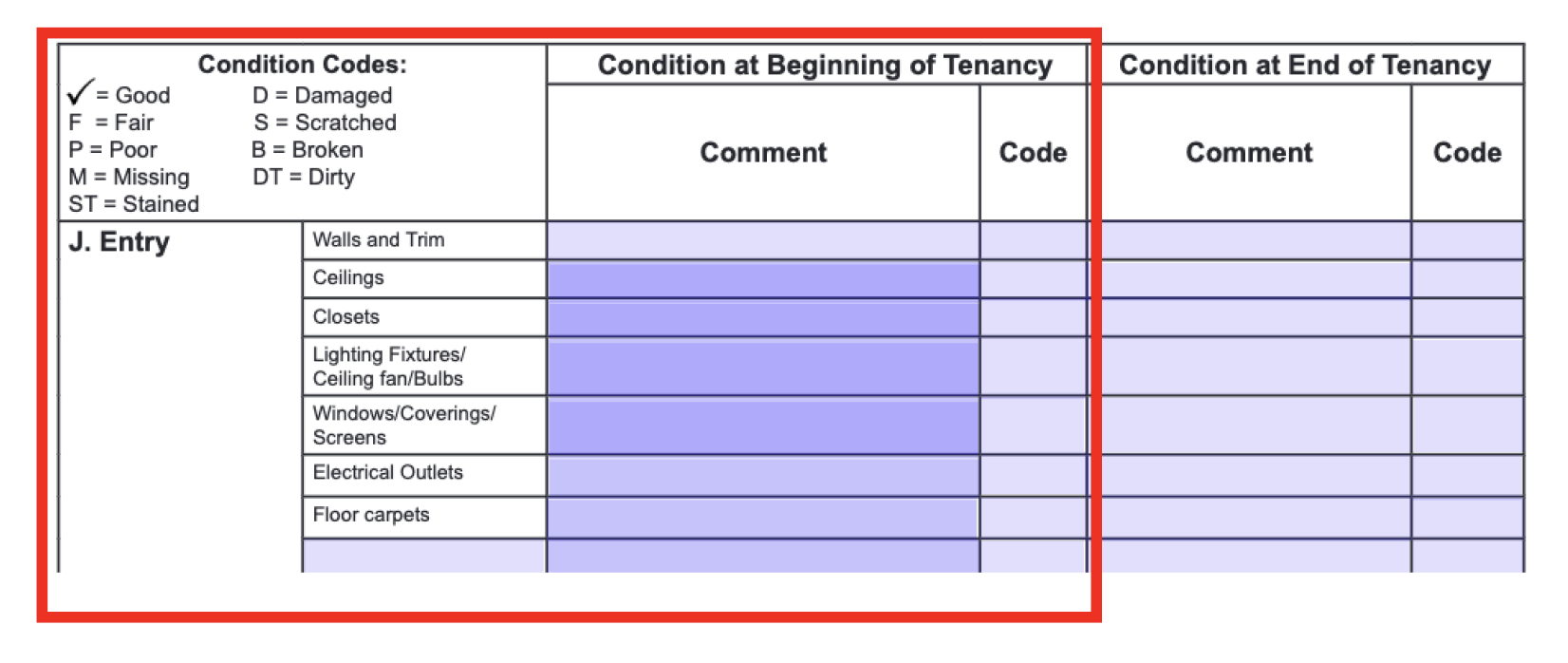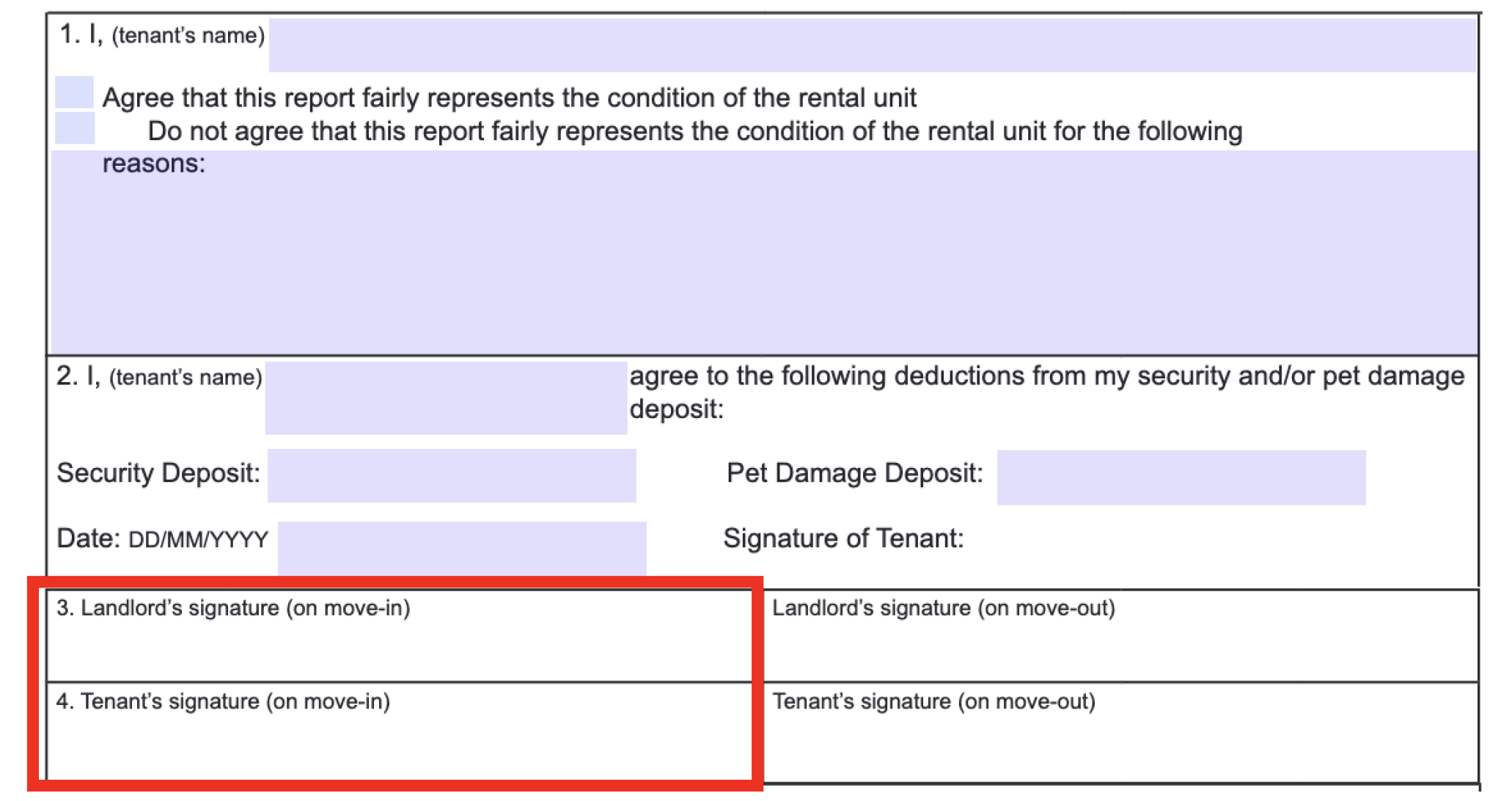Complete a move-in condition inspection report
On this page
- Condition inspection form
- What the form contains
- Relevant parts of the form
- Recording the condition of a feature
- Repairs needed at the start of the tenancy
- Tenant disagrees with what the landlord has written
- Signing the form
- I need help
Condition inspection form
Condition Inspection Report (PDF, 1.3MB)
About the process
The landlord should fill in the form as they walk through the unit with the tenant.
- Learn more about the condition inspection process
What the form contains
There is space on the form for notes on the inspection of the following spaces:
- Entryway
- Kitchen
- Living room
- Dining room
- Stairwell and hall
- The bathroom
- The bedrooms
- The exterior of the building or unit
- Utility room
- Garage or parking area
- Basement
- Storage area
- Keys and controls
The unit has fewer rooms than the form
If the unit doesn’t contain one of these room types, the landlord should cross it out or write not applicable on the form.
The unit has more rooms than the form
The landlord should print additional pages to capture additional rooms. They should cross out the existing room name and add a new name that clearly describes the room.
Relevant parts of the form
 The condition inspection form has columns for the condition at the beginning of the tenancy and columns for the condition at the end of the tenancy. The landlord should only fill in the condition at beginning of tenancy during the move-in inspection.
The condition inspection form has columns for the condition at the beginning of the tenancy and columns for the condition at the end of the tenancy. The landlord should only fill in the condition at beginning of tenancy during the move-in inspection.
Recording the condition of a feature
Room name
The room name is in the far left column of the form. The landlord can add detail to that column to make it clear what room is being discussed. In the picture, the room is called entry.
Features of the room
The form lists a few features for each room. For example, in the entry the features are:
- Walls and trim: the walls, as well as any moulding or trim at the tops or bottoms of the walls and around any windows
- Ceilings
- Closets
- Lighting fixtures/ceiling fan/bulbs: anything relating to the lighting in the room, including light switches
- Windows/coverings/screens: the windows themselves, any blinds or curtains, and screens
- Electrical outlets: anything relating to power outlets in the room
- Floor carpets: the floor coverings, including laminate, hardwood, rugs and carpets
- Blank space: used to add another feature, like furniture or appliances
Comment
The comment section is where the landlord should describe any damage. If there is no damage, the landlord can use a checkmark. There isn’t much space, so descriptions should be short and clear.
Damage and cleanliness codes
Codes are an additional way to describe the condition of each feature. There are codes for damage and codes for cleanliness. The landlord should record a code for damage and a code for cleanliness for each feature.
The codes for damage are:
- Check-mark: good condition, meaning the feature is undamaged
- F: fair condition, meaning it’s maybe a little worn but clean and undamaged
- P: poor condition, meaning it’s wearing out and will need to be replaced
- M: missing, meaning the feature is not present in the room (but should be)
The codes for cleanliness are:
- Check-mark: good condition, meaning the feature is clean
- ST: stained, meaning the feature has a permanent mark or discolouration
- D: damaged, meaning the feature still works but is in bad shape
- S: scratched, meaning the feature has surface damage
- DT: dirty, meaning the feature is marked or discoloured but can be cleaned
Repairs needed at the start of the tenancy
If the unit is damaged and repairs are needed, the landlord should note them in the X. Start of tenancy box. The landlord is responsible for doing repairs in a reasonable amount of time. The tenancy is usually considered to start when the tenant takes occupancy of the unit.
Tenant disagrees with what the landlord has written
The landlord must give the tenant an opportunity at the end of the inspection to review the report.
If the tenant does not agree with how the landlord has described the condition of a room or feature, they should check the Do not agree that this report fairly represents the condition of the rental unit for the following reasons box.

Then in the text box, the tenant can explain what they disagree with. The tenant should include:
- The room
- The feature
- A description of its condition
Signing the form

Do not complete sections 1 and 2 on page 6 at the start of the tenancy. Both the tenant and the landlord should sign the form at the end of the condition inspection.
The landlord’s signature goes in the 3. Landlord’s signature (on move-in) box. The tenant’s signature goes in the box labelled “Tenant’s signature (on move-in).”
I need help
